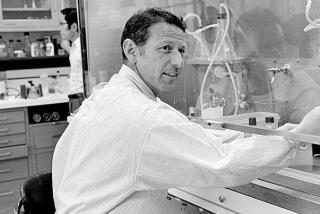Lack of Recognition Embitters Some Pioneers of Artificial Heart Design
- Share via
SALT LAKE CITY — Dr. Robert Jarvik’s offices at Symbion Inc. are a monument to Robert Jarvik. The walls are decorated with glossy magazine covers about the man-made heart that bears his name. There he is on Italian men’s Vogue--hair tousled, crooked smile, hand curled around “the Jarvik.”
But next door, in a funky building owned by the University of Utah, a smudged display case traces the artificial heart’s bloodline. A dozen crude prototypes line the cupboard. There are the Wertheimer, the Donovan, the Kwan-Gett, the early designs of Dr. Willem Kolff.
These days, Dr. Clifford Kwan-Gett is convinced that his role has been ignored. Meanwhile, Kolff and Jarvik barely speak. Though their latest hearts are being tested alongside one another in the university labs, there is rigid separation of computers, sheep and calves.
Other early pioneers of the Utah artificial heart are bitter too.
Tom Kessler was one of the first employees of Kolff’s lab. Trained to make dental prostheses, he spent 15 years constructing hearts. “He probably did more to design the actual Jarvik than Jarvik did,” Dr. William C. DeVries said. “He built it. He made it pump.”
But in 1983, after DeVries first put the heart in a human, Kessler withdrew quietly from the crusade to which he had given his career. Now he works in electronics in Salt Lake City. The evolution of the artificial heart program makes him sad.
“Things change; times change; it becomes a business. And someone has to pay for it,” he said ruefully. “It’s sort of like the difference between Chuck Yeager breaking the sound barrier and any pilot comes along now and can do it with the bat of an eye.”
“I think that all of the original employees feel that way,” said DeVries, now in Kentucky implanting hearts under the auspices of the profit-making health care giant, Humana Inc. “They feel like they were part of something that was so neat, so young. All of a sudden, bam! It skyrocketed.
“All of those guys felt like they developed this thing and all of a sudden someone came in and took it, and it was gone. It was out of their hands. I think there were a lot of noses out of joint.”
The artificial heart landed in Utah in 1967, the year the university brought Kolff in to start a division of artificial organs. The Dutch-born scientist had developed the first useful artificial kidney and had been among the first to put a mechanical heart in a dog.
Over the next 13 years, several hundred researchers passed through Kolff’s lab. They worked on pneumatic heart drivers, experimented with plastics, tested anti-coagulants. Hearts went into lab animals; the sheep and calves died; autopsies were performed.
Slowly, the heart evolved.
Among the young researchers Kolff took in was Jarvik, a clever inventor enrolled in an Italian medical school, unable to gain admission in the United States. Kolff helped him get admission to the University of Utah Medical School, and upon graduation, Jarvik went to work in the lab full time.
In the mid-1970s, Jarvik modified the earlier Kwan-Gett heart. It got a better fit, larger blood volume per stroke, new diaphragm design and a new name. Later, with calves living longer, he and Kessler redesigned the Jarvik-5 into the smaller, human-size Jarvik-7.
But for many, the decision to “go into human” proved shattering.
Suddenly, the artificial heart was the lead story on evening network news. The focus had shifted from lab to hospital and from the university to Kolff Medical, the company Kolff and Jarvik had formed several years earlier.
Kessler and others were asked to train a new generation of researchers and technicians.
DeVries believes that there was a lot of “mysticism” about putting the heart into people--”that when you are doing animal experimentation, it’s one thing, but when you deal with humans, that’s another plane.” Some people were frightened by it, he said.
Now the implant program has left Utah altogether, gone with DeVries in 1984 when he accepted Humana’s offer to back the next 100 implants. No artificial hearts have been used at the university hospital since DeVries left, either as a permanent or temporary device.
Jarvik has severed his ties with the university. He now heads the corporation, promotes the heart worldwide and is profiled in magazines like Playboy. A bitter struggle for control of the company left Jarvik in and Kolff out. The name has been changed to Symbion.
Kwan-Gett is a cardiologist in Salt Lake City. In part because of his complaints, the University of Utah credits him widely in literature about the heart. Nevertheless, he complained sourly in a recent interview that the university had ignored his role.
Now in his late 70s, Kolff has stepped down from his position in charge of the artificial organs program. He remains a professor and is developing a new artificial heart. For the first time in nearly 20 years, the heart has a generic name: The Utah 100.
“He’s really on the periphery, and it’s been very unfortunate, I think,” DeVries said. “Because he’s a tremendous person and he’s not getting the credit he deserves. I mean, the Jarvik heart and all that stuff, that really is Kolff’s heart. He invented it. He started the whole thing. I wouldn’t be where I am and Jarvik wouldn’t be where he is and the whole project wouldn’t be without him. He’s the centerpiece of the whole thing.”
More to Read
Inside the business of entertainment
The Wide Shot brings you news, analysis and insights on everything from streaming wars to production — and what it all means for the future.
You may occasionally receive promotional content from the Los Angeles Times.










